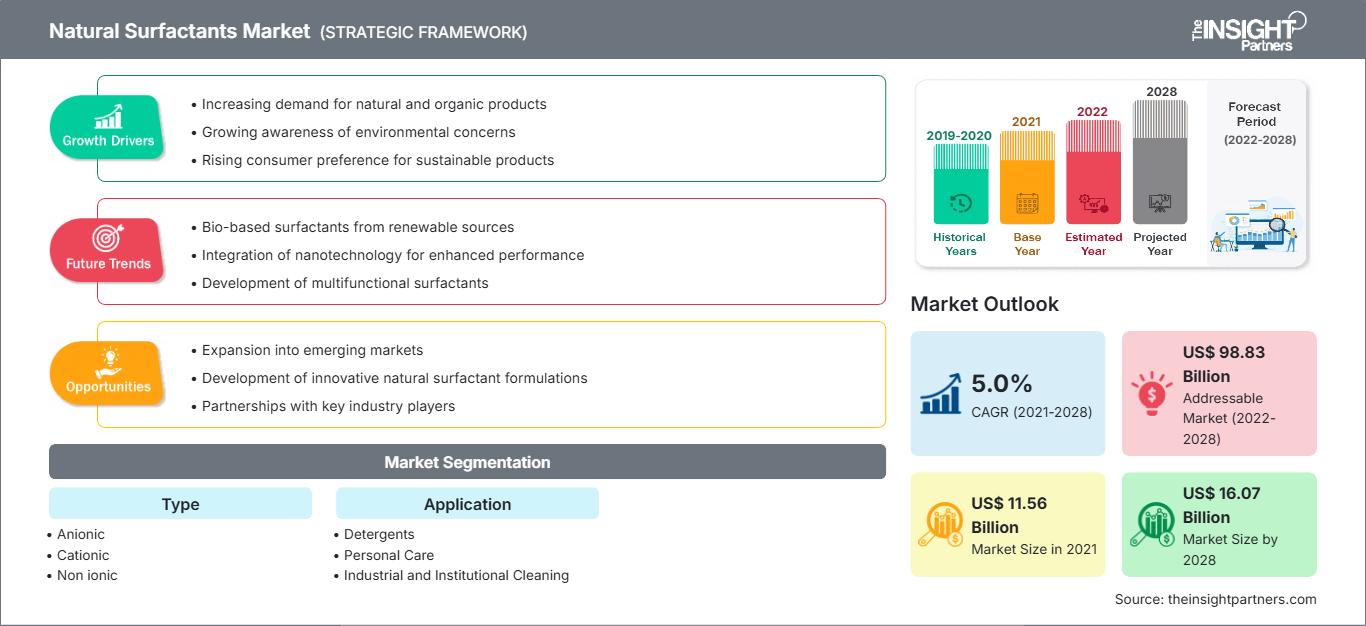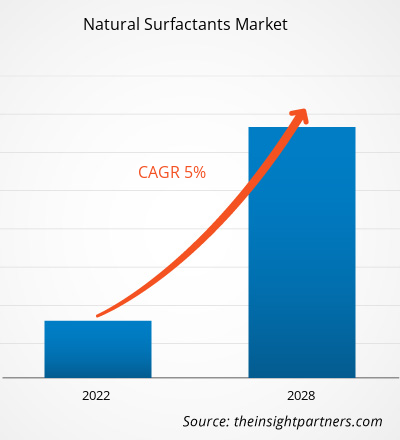[Rapporto di ricerca]Si prevede che il mercato dei tensioattivi naturali crescerà da 11.558,34 milioni di dollari nel 2021 a 16.069,28 milioni di dollari entro il 2028; si stima una crescita a un CAGR del 5,0% dal 2022 al 2028.
I tensioattivi naturali derivano da diversi tipi di piante. Le fonti più comuni includono cocco o palma, ma possono anche essere derivati da altri tipi di frutta e verdura. Inoltre, i tensioattivi naturali possono essere prodotti anche da scarti e sottoprodotti industriali. I tensioattivi naturali sono più facilmente biodegradabili rispetto alle loro controparti sintetiche grazie alla loro origine biologica.
Nel 2021, l'Asia-Pacifico ha detenuto la quota di fatturato maggiore del mercato globale dei tensioattivi naturali. I principali fattori che guidano il mercato dei tensioattivi naturali nell'area Asia-Pacifico sono la crescente consapevolezza dei benefici di questi prodotti e il loro crescente utilizzo in diverse applicazioni, come detergenti, cosmetici e prodotti per la cura della persona, pulizie industriali e agricoltura. I tensioattivi di sintesi chimica, essendo a base di petrolio, sono generalmente non biodegradabili e tossici per l'ambiente. I processi di produzione di tensioattivi sintetici e dei loro sottoprodotti possono essere pericolosi per l'ambiente. Di conseguenza, vi è una crescente consapevolezza della necessità di proteggere l'ambiente. Pertanto, l'uso di tensioattivi naturali è in aumento nella regione, trainando la crescita del mercato dei tensioattivi naturali nell'area Asia-Pacifico.
Personalizza questo rapporto in base alle tue esigenze
Potrai personalizzare gratuitamente qualsiasi rapporto, comprese parti di questo rapporto, o analisi a livello di paese, pacchetto dati Excel, oltre a usufruire di grandi offerte e sconti per start-up e università
Mercato dei tensioattivi naturali: Approfondimenti strategici

-
Ottieni le principali tendenze chiave del mercato di questo rapporto.Questo campione GRATUITO includerà l'analisi dei dati, che vanno dalle tendenze di mercato alle stime e alle previsioni.
Impatto della pandemia di COVID-19 sul mercato dei tensioattivi naturali
Prima della pandemia di COVID-19, il mercato dei tensioattivi naturali era principalmente trainato dal loro crescente utilizzo in vari settori come la cura della persona, i detergenti, la pulizia industriale e istituzionale, i prodotti chimici per i giacimenti petroliferi, i prodotti chimici per l'agricoltura e altri. Tuttavia, nel 2020, diversi settori hanno dovuto rallentare le proprie attività a causa delle interruzioni nelle catene del valore causate dalla chiusura dei confini nazionali e internazionali. La pandemia di COVID-19 ha causato interruzioni nella catena di approvvigionamento di materie prime chiave e ha ostacolato i processi di produzione a causa delle restrizioni imposte dalle autorità governative in numerosi paesi. La domanda di tensioattivi naturali da parte di vari settori è diminuita a causa della chiusura delle industrie.
La domanda di prodotti per l'igiene personale e la cura della casa è cresciuta a causa della pandemia di COVID-19, che ha avuto un impatto positivo sulla produzione di tensioattivi naturali per uso domestico e altre applicazioni. Inoltre, i tensioattivi naturali svolgono un ruolo chiave nella lotta alla pandemia. I tensioattivi naturali comuni sono utilizzati in saponi e altri prodotti per la pulizia personale, detersivi per il bucato e detergenti per superfici solide per disattivare il SARS-CoV-2 e rimuoverlo dalla pelle e da altre superfici.
Approfondimenti di mercato
Crescente domanda di detersivi per uso domestico
Con la crescente prevalenza di malattie infettive, in particolare il COVID-19, le persone stanno diventando più consapevoli della pulizia e dell'igiene. L'importanza della disinfezione delle mani, dell'igiene e della pulizia è aumentata a causa della rapida comparsa di malattie infettive come il norovirus e l'influenza. La necessità di detersivi per uso domestico è in crescita a causa del crescente utilizzo di detersivi per il bucato e prodotti per la pulizia della casa.
I detersivi sono comunemente utilizzati per la pulizia perché uniscono acqua e olio, rendendoli efficaci contro macchie oleose e grasso. Gli operatori sanitari stanno conducendo campagne di sensibilizzazione sull'igiene in diversi paesi in via di sviluppo per attirare l'attenzione dei clienti e sensibilizzarli. Di conseguenza, i consumatori’ La domanda di prodotti per la cura della persona e la pulizia della casa è in aumento.
Approfondimenti sulla tipologia
In base alla tipologia, il mercato globale dei tensioattivi naturali è segmentato in anionici, cationici, non ionici e anfoteri. Il segmento anionico ha detenuto la maggiore quota di mercato dei tensioattivi naturali nel 2021. I tensioattivi anionici sono caratterizzati da un gruppo polare idrofilo con carica negativa. Sono i tensioattivi più comunemente utilizzati grazie al loro miglior potere detergente e all'elevata quantità di schiuma prodotta. Questi tensioattivi sono i migliori per la pulizia, poiché puliscono utilizzando la repulsione carica. I tensioattivi anionici sono eccellenti nella rimozione di sporco, argilla e alcune macchie oleose. Questi tensioattivi anionici si trovano in shampoo, bagnoschiuma, dentifricio, ecc. Glutammato, cocoato di potassio, isetionato e sodio cocco solfato sono alcuni esempi di tensioattivi anionici naturali.
Tra i principali attori del mercato globale dei tensioattivi naturali figurano BASF SE, Clariant AG, Croda International Plc, Dow Inc., KAO Corporation, Lankem Ltd., Solvay SA, Arkema, Stepan Company ed Evonik Industries AG. Gli operatori del mercato dei tensioattivi naturali si concentrano sulla fornitura di prodotti di alta qualità per soddisfare la domanda dei clienti. Si stanno inoltre concentrando su strategie quali investimenti in attività di ricerca e sviluppo e lanci di nuovi prodotti.
In evidenza nel rapporto
- Tendenze progressive del settore nel mercato dei tensioattivi naturali per aiutare gli operatori a sviluppare strategie efficaci a lungo termine
- Strategie di crescita aziendale adottate dai mercati sviluppati e in via di sviluppo
- Analisi quantitativa del mercato dei tensioattivi naturali dal 2020 al 2028
- Stima della domanda globale di tensioattivi naturali
- Analisi delle cinque forze di Porter per illustrare l'efficacia di acquirenti e fornitori che operano nel settore
- Sviluppi recenti per comprendere lo scenario competitivo del mercato
- Tendenze e prospettive di mercato, nonché fattori che guidano e frenano la crescita del mercato dei tensioattivi naturali
- Assistenza nel processo decisionale evidenziando le strategie di mercato che sostengono l'interesse commerciale, portando alla crescita del mercato dei tensioattivi naturali
- Dimensioni del mercato dei tensioattivi naturali in vari nodi
- Panoramica dettagliata e segmentazione del mercato, nonché dinamiche del settore dei tensioattivi naturali
- Dimensioni del mercato dei tensioattivi naturali in varie regioni con promettenti opportunità di crescita
Le tendenze regionali e i fattori che influenzano il mercato dei tensioattivi naturali durante il periodo di previsione sono stati ampiamente spiegati dagli analisti di The Insight Partners. Questa sezione illustra anche i segmenti e la geografia del mercato dei tensioattivi naturali in Nord America, Europa, Asia-Pacifico, Medio Oriente e Africa, America meridionale e centrale.
Ambito del rapporto sul mercato dei tensioattivi naturali
| Attributo del rapporto | Dettagli |
|---|---|
| Dimensioni del mercato in 2021 | US$ 11.56 Billion |
| Dimensioni del mercato per 2028 | US$ 16.07 Billion |
| CAGR globale (2021 - 2028) | 5.0% |
| Dati storici | 2019-2020 |
| Periodo di previsione | 2022-2028 |
| Segmenti coperti |
By Tipo
|
| Regioni e paesi coperti |
Nord America
|
| Leader di mercato e profili aziendali chiave |
|
Densità degli operatori del mercato dei tensioattivi naturali: comprendere il suo impatto sulle dinamiche aziendali
Il mercato dei tensioattivi naturali è in rapida crescita, trainato dalla crescente domanda da parte degli utenti finali, dovuta a fattori quali l'evoluzione delle preferenze dei consumatori, i progressi tecnologici e una maggiore consapevolezza dei benefici del prodotto. Con l'aumento della domanda, le aziende stanno ampliando la propria offerta, innovando per soddisfare le esigenze dei consumatori e sfruttando le tendenze emergenti, alimentando ulteriormente la crescita del mercato.

- Ottieni il Mercato dei tensioattivi naturali Panoramica dei principali attori chiave
Mercato globale dei tensioattivi naturali
Per tipo
- Anionici
- Glutammato
- Cocacoato di potassio
- Isetionato
- Altri
- Cationici
- Brassicil isoleucinato esilato
- Metosolfato di ammonio dialchilestere
- Esterquat, cloruro di benzalconio
- Polyquaternium
- CTAC (cloruro di cetrimonio)
- BTAC (cloruro di behentrimonio)
- Altri
- Non ionici
- Saponine
- Glucosidi
- Gliceridi
- Etossilati
- Cocamide MEA (CMEA)
- Cocamide DEA (CDEA)
- Altri
- Anfoteri
- Betaine
- Anfoacetati
- Sultaine
- Ossidi di ammina e altri
Per applicazione
- Detergenti
- Cura della persona
- Pulizia industriale e istituzionale
- Prodotti chimici per giacimenti petroliferi
- Prodotti chimici per l'agricoltura
- Altri
Profili aziendali
- BASF SE
- Clariant AG
- Croda International Plc
- Dow Inc.
- KAO Corporation
- Lankem Ltd.
- Solvay SA
- Arkema
- Stepan Company
- Evonik Industries AG
- Analisi storica (2 anni), anno base, previsione (7 anni) con CAGR
- Analisi PEST e SWOT
- Valore/volume delle dimensioni del mercato - Globale, Regionale, Nazionale
- Industria e panorama competitivo
- Set di dati Excel
Report recenti
Testimonianze
Motivo dell'acquisto
- Processo decisionale informato
- Comprensione delle dinamiche di mercato
- Analisi competitiva
- Analisi dei clienti
- Previsioni di mercato
- Mitigazione del rischio
- Pianificazione strategica
- Giustificazione degli investimenti
- Identificazione dei mercati emergenti
- Miglioramento delle strategie di marketing
- Aumento dell'efficienza operativa
- Allineamento alle tendenze normative






















 Ottieni un campione gratuito per - Mercato dei tensioattivi naturali
Ottieni un campione gratuito per - Mercato dei tensioattivi naturali